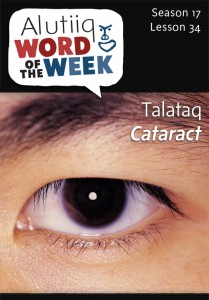Talatangq’rtuq. – He has cataracts.
Cataracts are a common problem among older people. As we age, proteins build up in the clear discs, or lenses, that form the center of our eyes. This slow process gradually reduces the amount of light that reaches the eyes, clouding vision. It also alters people’s perceptions of color, increases the effects of glare, and enhances nearsightedness. Cataracts can develop from an eye injury or disease. Infections, diabetes, and exposure to toxic substances or intense light can all cause this degenerative condition. A few people are even born with cataracts.
Cataract surgeries are thousands of years old. From ancient Egypt to the Roman world, Japan, and Native America, people sought ways to restore sight by removing cataracts. Historic accounts from Alaska indicate that eye problems were common among Native people. Eye irritations, infections, and injuries were widely observed, as was clouding of the eyes. This clouding may have been from cataracts or from disease of the cornea, the outer surface of the eye. Alutiiq peoples treated this problem in an ingenious way.
In 1805, Archmandrite Iosaf Blotov, the Russian cleric who led the first Russian Orthodox mission to American, wrote about the use of lice in eye surgeries. According to his account, people fastened a live louse to a fine hair and lowered it into a person’s eye. When the insect attached its-self to the film in the eye, it was yanked out and the process repeated. Some people interpret this as a technique for removing cataracts. It is more likely that the practice helped to remove an opacity from the cornea. The Inupiaq people of northern Alaska also used this procedure.

